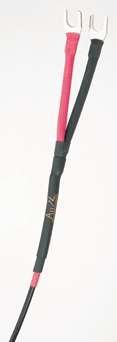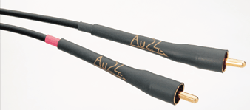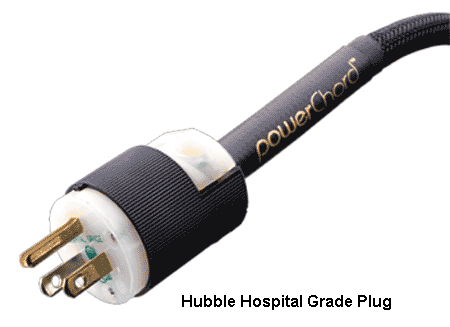Audience Audio Cables
| Audience Audio Cables |
|
Henry Wilkenson |
|
10 July 2001 |
 Specifications
Specifications
1 Meter Au24 Analog Audio Interconnect Cable (unbalanced), $417.00 per pair
1 Meter Au24 Analog Audio Interconnect Cable (balanced XLR), $776.00 per pair
8’Au24 High Resolution Loudspeaker Cables, $942.00 per pair
1Meter Au24 S/PDIF Cable, $228.00
6’ powerChord, $379.00
Web: www.Audience-av.com
You will always find people going against the grain, swimming upstream, if you will. Dennis Rodman certainly qualifies. This can also be said of some audio companies. After receiving samples of their cables, I have to believe that Audience is just such a company.
Many high-end audio cables today resemble anacondas. It would seem that some manufactures are competing to become the heavyweight champs of the cable world. As you can see from the above picture, Audience has gone in the opposite direction. With the exception of the powerChord, their interconnects and speaker cables are the same size, about one-quarter to one-half the size of your average lamp cord! As a result, they are flexible and easy to manage. The rule here is good sonics over fashion.
 According to the product literature, all Audience Au24 cables utilize “OHNO Continuous Cast, Single Crystal Copper” conductors of coaxial construction with polypropylene insulation. The jacket material is made of cross-linked XLPE polyethylene. The electrical properties are specifically optimized for each cable’s particular purpose. All Audience cables, and especially the Au24 series, are designed for low eddy-current resistance. Richard A. Smith, the Director of Product Development at Audience, states in the product literature,
According to the product literature, all Audience Au24 cables utilize “OHNO Continuous Cast, Single Crystal Copper” conductors of coaxial construction with polypropylene insulation. The jacket material is made of cross-linked XLPE polyethylene. The electrical properties are specifically optimized for each cable’s particular purpose. All Audience cables, and especially the Au24 series, are designed for low eddy-current resistance. Richard A. Smith, the Director of Product Development at Audience, states in the product literature,
This is the key electrical characteristic for good time response. Eddy-currents are created by the magnetic field the electrical signal creates around the cable. This field builds up and collapses as the signal varies. When the field collapses it induces an opposing voltage back into the cable. This late arriving, opposing voltage resists the original signal. The signal is now being modulated by a time smearing artifact. These effects are clearly audible. Cables that sound detailed or powerful in the bass are usually victims of high eddy-currents. Since the Au24 cables exhibit extremely low eddy-current resistance, the result is natural reproduction as heard in real life without added emphasis or editorializing.
I particularly liked Audience’s proprietary RCA connectors. They are smaller that what you will typically find on other interconnects, yet are easy to handle, facilitating routing and swapping. As a reviewer, this is something I really appreciate.
 The powerChord is a low-impedance, low-resistance device designed to reject noise and interference while radiating less energy to surrounding cables. Wattgate IEC and Hubbell Hospital grade plugs are used on standard configurations. The insulating materials exhibit extremely low dielectric absorption, as a design feature largely responsible for the cable’s very low noise floor. This power cord is quite flexible. Since it is not a solid-core design, it avoids the damage that solid-core designs suffer when they are bent, or worse, crimped. Even so, I am careful not to bend these cords more than necessary. Old habits die hard.
The powerChord is a low-impedance, low-resistance device designed to reject noise and interference while radiating less energy to surrounding cables. Wattgate IEC and Hubbell Hospital grade plugs are used on standard configurations. The insulating materials exhibit extremely low dielectric absorption, as a design feature largely responsible for the cable’s very low noise floor. This power cord is quite flexible. Since it is not a solid-core design, it avoids the damage that solid-core designs suffer when they are bent, or worse, crimped. Even so, I am careful not to bend these cords more than necessary. Old habits die hard.
The powerChord and all other Audience cables come with a 30-day return policy and a lifetime guarantee. That is an unconditional lifetime guarantee! Simply return any defective or damaged cable and Audience will repair or replace it free of charge. How many companies can you think of that stand behind their products this way?
Well, How Do They Sound?
As I stated earlier, the Au24 interconnect is a cinch to install. However, I chose to begin this review by only installing the powerChords. Once I had them in place, I immediately noticed that the system sounded smoother. It was as if some slightly rough edges had been removed. This was not in any way an exaggerated effect. It was very subtle, yet audible.
The Au24 interconnects remind me of a pair of Koss 1030 speakers I once owned. There was nothing about the sound that jumped out and grabbed you. At the time, there were top-selling speakers with sizzling top ends or overwhelming bass, all out of balance in one way or another. The Kosses were much better balanced and, as a result, more listenable over the long haul.
Once the Au24s were installed, I fired up the system, sat back for a listen and – nothing. Of course they worked. What I mean is this: Similar to the Kosses, there was no sonic emphasis of any one area. From top to bottom, they were consistently balanced. Cymbals were in perspective with the rest of the drum kit, where previously they seemed to be much too big in relation with the rest of the stage. There were instances where the cables were not able to overrule the recording. I could clearly hear the recording engineer’s hand at work on a number of studio recordings. These cables are very good at revealing musical detail as well as any anomalies. They will also allow one to immediately hear the differences between various components inserted into the system.
Their small size notwithstanding, the interconnects and speaker wire are shielded very well. Initially, I was somewhat concerned about RFI and any other interference that might be lurking about. My concerns soon vanished; the music emerged from a dead silent background. I never detected RFI or any stray noises coming from the speakers. This is very good given the fact that I reside in RFI Central.
With all of the Audience cables in the system, the sound took on a more subtle harmonic richness. I could discern slight instrumental textures and other low-level details that previously went unnoticed. This is the kind of detail that I always find to be musically relevant. No, I didn’t hear any pins dropping in the third row, but that’s not what I want to hear. Fortunately, I heard none of the hyper-detail so often linked to a cold or hard tonal quality. I found the timbre of individual instruments to be more intense. For instance, on Miles Davis’s Kind of Blue, it was as if I could hear more of Miles’ horn. The timbre seemed to somehow be more intense. Additionally, there were several passages where Miles is using a very slight vibrato. I do not always hear this in this recording. The tonal differences between Coltrane and Cannonball were also much more apparent.
While my system tends to come down on the slightly warm side, I have been able to maintain a high degree of midrange transparency. The Audience cables not only maintained the tonal balance that I prefer, they actually increased midrange transparency. Bass was extended and tight right on down to my speakers’ limitations, with just the right proportions of attack, body and weight. I have heard the opening bass line to So What sound quite muddy. This isn’t unusual for a recording of this vintage, but the Audience cables rendered the most realistic sound in this area I have heard so far. It was much tighter and just sounded more like an upright bass.
Male and female voices were equally well served. I found male vocals to have the proper amount of chestiness where appropriate. Female vocalists at times exhibited a little less sibilance than I have heard before but still sounded quite natural. This is an area where detail can be carried much too far, as when you feel you’re sitting a few inches from a performers mouth. Once again, nothing was exaggerated. Balance and proportion are the terms that I keep coming back to in my listening notes.
The imaging was very good laterally, with instruments spread across the entire stage. I find imaging to be a tricky thing. It’s another area where you can easily end up with too much of a good thing. When images are presented with razor-sharp edges, as if they were sonic cutouts, to my ear, this sounds anything but natural. At live events, with my eyes closed, I have never heard etched images. The further away I sit from the stage, the less precisely am I able to locate individual performers. Overdoing the imaging thing only serves to remind me that I am listening to a system. With the Audience cables in place, the images came across very naturally. While instrumentalists were easy to locate, there was no line of demarcation between or around performers. Studio recordings, where performers are isolated in booths, are of course the exception.
Depth was not as good as I have heard on some familiar recordings in other systems, but that is due to the sonic nature of my room. I did, however, manage to achieve a respectable amount of depth where it existed in the recording.
Since they do not call attention to themselves, trying to describe the sound of the Audience cables is difficult. They simply do a very good job of conveying the music. There are many products on the market today that claim to do this but fail to deliver. These products perform as advertised.
Given the prices of audio cables today, these Audience cables occupy the low-to-moderate end of the high-end scale. I find them to be a very good value in terms of their performance. If it is your intention to use interconnects and speaker wire as tone controls or equalizers, then you should look elsewhere. If, however, your goal is to achieve a sonic signature that is balanced from top to bottom with that elusive truth-of-timbre, then the Audience line belongs on your short list.
Music
-
Cannonball Adderley, Something Else, Blue Note 1595
-
Patricia Barber, Companion, Blue Note
-
Joshua Breakstone, Trio, 9 by 3, Contemporary
-
Charlie Byrd, for Louis, Concord Jazz
-
Kevin Mahogany, Songs and Moments, Enja
-
Arthur Prysock Count Basie, Vocal Classics, PolyGram Jazz
![]()
Don’t forget to bookmark us! (CTRL-SHFT-D)
Stereo Times Masthead
Publisher/Founder
Clement Perry
Editor
Dave Thomas
Senior Editors
Frank Alles, Mike Girardi, Russell Lichter, Terry London, Moreno Mitchell, Paul Szabady, Bill Wells, Mike Wright, and Stephen Yan,
Current Contributors
David Abramson, Tim Barrall, Dave Allison, Ron Cook, Lewis Dardick, John Hoffman, Dan Secula, Don Shaulis, Greg Simmons, Eric Teh, Greg Voth, Richard Willie, Ed Van Winkle, Rob Dockery, Richard Doran, and Daveed Turek
Site Management Clement Perry
Ad Designer: Martin Perry





Be the first to comment on: Audience Audio Cables